
The sap beetles, also known as Nitidulidae, are a family of beetles.
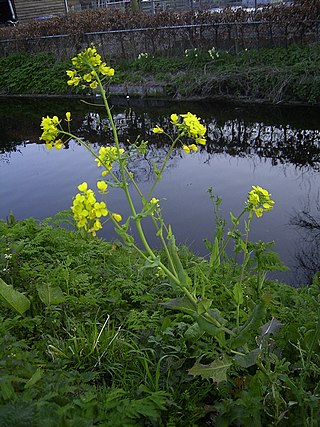
Brassica is a genus of plants in the cabbage and mustard family (Brassicaceae). The members of the genus are informally known as cruciferous vegetables, cabbages, mustard plants, or simply brassicas. Crops from this genus are sometimes called cole crops—derived from the Latin caulis, denoting the stem or stalk of a plant.

Rapeseed, also known as rape and oilseed rape, is a bright-yellow flowering member of the family Brassicaceae, cultivated mainly for its oil-rich seed, which naturally contains appreciable amounts of erucic acid. The term "canola" denotes a group of rapeseed cultivars that were bred to have very low levels of erucic acid and which are especially prized for use as human and animal food. Rapeseed is the third-largest source of vegetable oil and the second-largest source of protein meal in the world.
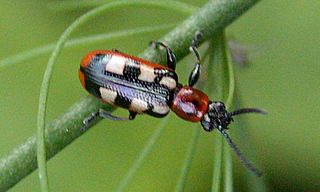
The common asparagus beetle is an important pest of asparagus crops both in Europe and in North America. Asparagus is its only food plant. The beetle is 6.0 mm to 9.5 mm long and slightly elongated. It is metallic blue-black in color with cream or yellow spots on its red-bordered elytra. The larvae are fat gray grubs with dark heads.

Delia flies are members of the Anthomyiidae family within the superfamily Muscoidae. The identification of different species of Delia can be very difficult for non-specialists as the diagnostic characteristics used for immature and/or female specimens may be inconsistent between species. Past taxonomic keys were not as comprehensive in their identification of Delia specimens; they were either too reliant on genetic characteristics, focused solely on a specific life stage, or were focused only on certain species. However current taxonomic keys aim to be more thorough by not only including morphological diagnostics for males, females, and immature specimens of various species, but also their genetic make-up or molecular barcode.
Leptosphaeria maculans is a fungal pathogen of the phylum Ascomycota that is the causal agent of blackleg disease on Brassica crops. Its genome has been sequenced, and L. maculans is a well-studied model phytopathogenic fungus. Symptoms of blackleg generally include basal stem cankers, small grey lesions on leaves, and root rot. The major yield loss is due to stem canker. The fungus is dispersed by the wind as ascospores or rain splash in the case of the conidia. L. maculans grows best in wet conditions and a temperature range of 5–20 degrees Celsius. Rotation of crops, removal of stubble, application of fungicide, and crop resistance are all used to manage blackleg. The fungus is an important pathogen of Brassica napus (canola) crops.
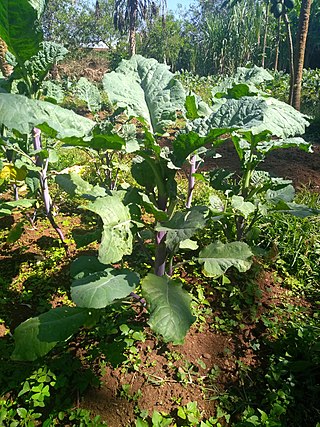
Brassica carinata is a species of flowering plant in the Brassicaceae family. It is referred to by the common names Ethiopian rape or Ethiopian mustard. It is believed to be a hybrid between Brassica nigra and Brassica oleracea.
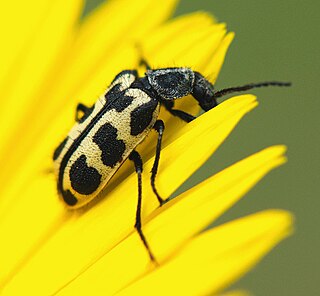
Astylus atromaculatus is a species of beetle in the family Melyridae. It is variously known as the spotted maize beetle, or pollen beetle. It is indigenous to Argentina and neighbouring countries, but has been accidentally imported into various other regions such as the warmer regions of North America and much of Africa, where it has become invasive.
Pollen beetle is an informal term for any species of beetle associated intimately with suitably pollen-rich species of flowers. Typically such a beetle is adapted to the pollen as a major part of its diet. Species in at least sixteen families of the order Coleoptera could be counted as pollen beetles, and "pollen beetle" also is a common name for some such species.

Agriotes sputator is a species of click beetle, commonly known as the common click beetle. The adult beetle is brown and inconspicuous, and the larvae live in the soil and are known as wireworms. They are agricultural pests that devour the roots and underground parts of many crops and other plants.
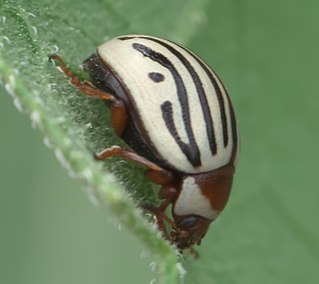
Zygogramma exclamationis, commonly known as the sunflower beetle, is a species of leaf beetle belonging to the family Zygogramma. It is regarded as a pest of sunflower crops in North America.
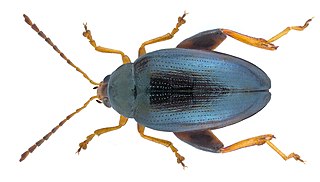
Psylliodes chrysocephala or Psylliodes chrysocephalus, commonly known as the cabbage-stem flea beetle, is a species of leaf beetle situated in the subfamily Galerucinae and the tribe Alticini.
Trichobaris trinotata, commonly known as the "Potato stalk borer", is a species of weevil in the family Curculionidae. It is found in North America where it is a pest of potato plants, the larvae tunnelling inside their stems.

Epuraea is a genus of sap-feeding beetles in the family Nitidulidae, first described in 1843 by Wilhelm Ferdinand Erichson. There are at least 40 described species in Epuraea. Their most notable food source is sap but these beetles also feed on organic matter such as fruits, flowers, fungi, decaying plant tissue, and the tissue of dead animals. Some species occur in bumblebee nests. Epuraea beetles commonly overwinter underneath logs or in soil.
Afrogethes canadensis is a species of pollen beetle in the family Nitidulidae.
Afrogethes is a genus of pollen beetles in the family Nitidulidae. There are at least 2 described species in Afrogethes.

Meligethinae is a subfamily of pollen beetles in the family Nitidulidae. There are about 6 genera and about 10 described species in Meligethinae.

Sphenophorus parvulus, commonly known as the bluegrass billbug, is a species of beetle in the true weevil family Curculionidae. It is found in North America, especially in the eastern United States. It is a pest of Kentucky bluegrass, corn and grain crops.

Brassicogethes is a genus of pollen beetles in the family Nitidulidae. There are at least 4 described species in Brassicogethes.

Malachius aeneus, the scarlet malachite beetle, is a species of soft-winged flower beetle in the family Melyridae. The beetle was introduced to North America in 1852, and is now widespread. The larvae are frequently found near cereal crops and are known predators of Brassicogethes aeneus in Great Britain.















